Cars of the USSR era: GAZ-21R "Volga" (third series)
The third issue of the Volga of the first generation lasted on the assembly line of the Gorky Automobile Plant from April 1962 to July 1970. During this time, 468,036 GAZ-21 and GAZ-22 vehicles of all modifications were built. After the modernization of 1965, the number of modifications only based on the sedan reached nine.
As part of the "modernization program" the following was done. Seventy horsepower of the base engine for a one and a half ton sedan (and even more so for a ferocious cargo-passenger version) was clearly not enough. One of the main Western competitors of the Volga - Volvo-120 1962 - the power-to-weight ratio was 0.0812 hp / kg; in the "twenty-first" this figure was almost two times lower - 0.0479 hp / kg. This meant that even the forced 80-horsepower engine, which was equipped with the export versions of the Volga, did not provide the necessary dynamics and speed.
Due to the use of pistons of a new design without changing both versions of the block head, it was possible to increase the compression ratio from 6.6 to 6.7 (in the forced version - from 7.15 to 7.65) and achieve an increase in power of 5 hp. (up to 75 and 85 hp respectively). For the manufacture of pistons and reinforcement of the piston pins, a more heat-resistant material began to be used. In addition, the camshaft cams and intake channels have undergone changes. A fine fuel filter appeared in the power system. A new open crankcase ventilation system prevented gumming in the intake system. As a result, the dynamics improved, albeit slightly: up to 100 km / h, the updated Volga accelerated 2-3 seconds faster than its predecessor. The increase in the passport maximum speed (from 132 to 135 km / h) was achieved only on export modifications. Fuel consumption has not changed.
In the transmission, instead of levers, hydraulic telescopic shock absorbers were used, which required a redesign of the upper front suspension arms. To increase the adjustment margin of the front wheel camber, an eccentric bushing was introduced into the mount of the upper arms.
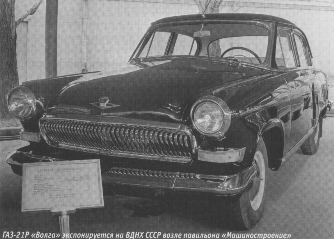
The salon has also been updated. The front sofa was made more comfortable, a new folding mechanism appeared, the “berth” formed by the seats became noticeably smoother. New synthetic materials have been used in the interior upholstery.
The ceiling was upholstered not with a fleecy fabric, but with a practical vinyl, not afraid of "wet cleaning"; fabric inserts on the inner door panels gave way to leatherette, and bizarre kinks were added to the moldings on the door cards.
The handle of the "exhaust" handbrake, located under the dashboard, has acquired a more ergonomic L-shaped shape. A new decorative overlay appeared on the horn button, and a silvery figurine of a Gorky deer on a beige background was framed by a wide embossed ring with a white sheen.
The restyling of the exterior was carried out under the guidance of its author, designer Lev Eremeev. With a few light touches, Eremeev and his colleagues managed, while retaining the original style of the "twenty-first", to give the "Volga" of the third edition a more modern and dynamic look.
The "deer" and the central molding have disappeared from the hood, the shape of the emblem has changed. The car received a new radiator lining - "whalebone" (37 narrow vertical slats in the frame), new sidelights that go into the sidewalls of the wings, new taillights, new bumpers - without complex curves "in plan", without fangs, with painted in color body lower half. The new decorative handle of the trunk lid has become stylized as one of Gorky's animalistic totems - a seagull. Thin chrome insert moldings appeared on the upward facing part of the front and rear fenders (on models with improved trim), door moldings became chrome (rather than aluminum).
In this form, the "twenty-first" and its "younger brother" station wagon GAZ-22, intended for export, lasted eight years on the conveyor.
In 1965, the Volga was once again (and last) modernized. Moreover, the changes were both “trifle” (for example, the length of the wiper blades increased, the upholstery pattern and the configuration of door card moldings were simplified), and “affecting the basics”: the engine was equipped with a new K-124 carburetor, the spars at the attachment point of the steering mechanism were strengthened, and the seats ball bearings in the front wheel hubs were occupied by roller bearings. In addition, the interior heating system has been improved.
"Twenty-first", finally, got rid of the letter "M" in the factory index (the Gorky Automobile Plant lost the name of Molotov back in 1957) and began to be officially called simply GAZ-21 - with a letter indicating a modification.
The last copy of the "twenty-first" - anthracite-colored GAZ-21US - rolled off the assembly line of the Gorky Automobile Plant on July 15, 1970.
For individuals, the price of the cheapest modifications of the third issue - "21L" and "21R" - was 5.5 thousand rubles. The most expensive modification - "21C" (forced version with improved finish) - cost a thousand more.
OUTSIDE AND INSIDE
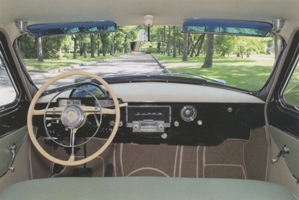 |
 |
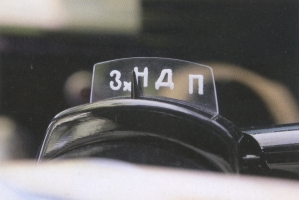 |
| The salon of cars "Volga" of the third series practically has not changed. | A rare modification of the GAZ-23 with a V8 engine and an automatic transmission from "Seagull" | On top of the steering column is the automatic transmission selector. |
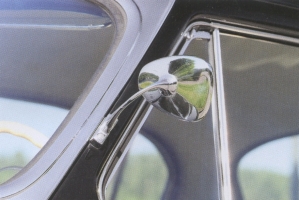 |
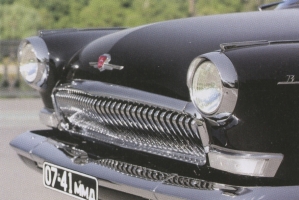 |
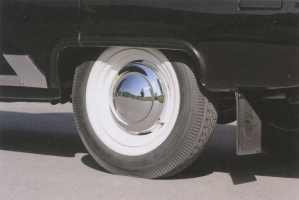 |
| Standard rear view mirror in chrome frame. | The multi-barred radiator grille ("whalebone") is the most noticeable distinguishing detail of the third series machines. | All Volga GAZ-21 cars and its modifications had such chrome-plated saucer caps. |
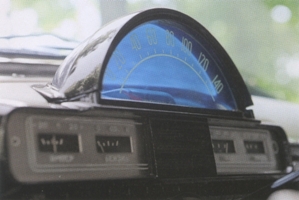 |
 |
 |
| The famous speedometer with a transparent "sphere" made of colored plastic | The loudspeaker speaker was located directly above the receiver. | Another characteristic detail of the "Volga" of the third series is the taillight of an updated form with a built-in reflector. |
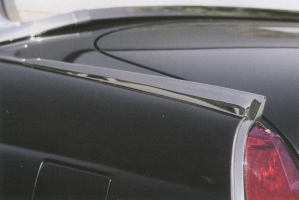 |
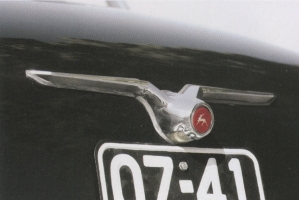 |
 |
| A chrome molding keel over the rear fender was only fitted to upgraded trim models. | An elegant "bird" on the trunk lid is a license plate light. | The vertically mounted spare wheel didn't take up much space in the trunk. |
 |
Bumpers of a new shape and rear lights without a chrome frame visually "unloaded" the stern of the car. | |
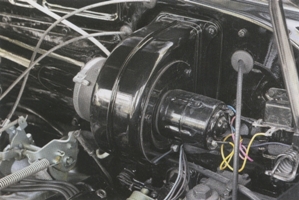 |
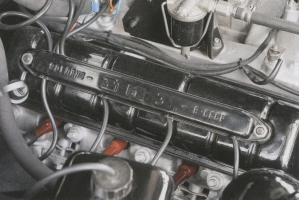 |
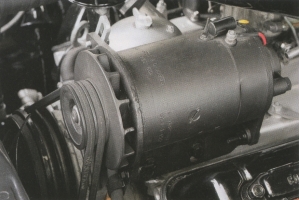 |
| Body heating fan. | On the valve cover of the engine, the letters "ZMZ" (Zavolzhsky Motor Plant) and a proud inscription "Made in USSR". | The generator is mounted above the engine block. |
| The eight-cylinder V-shaped engine from the "Seagull" was a bit cramped in the engine compartment of the "Volga". | 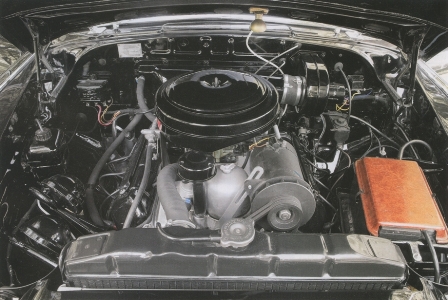 |
|
PASSPORT DATA
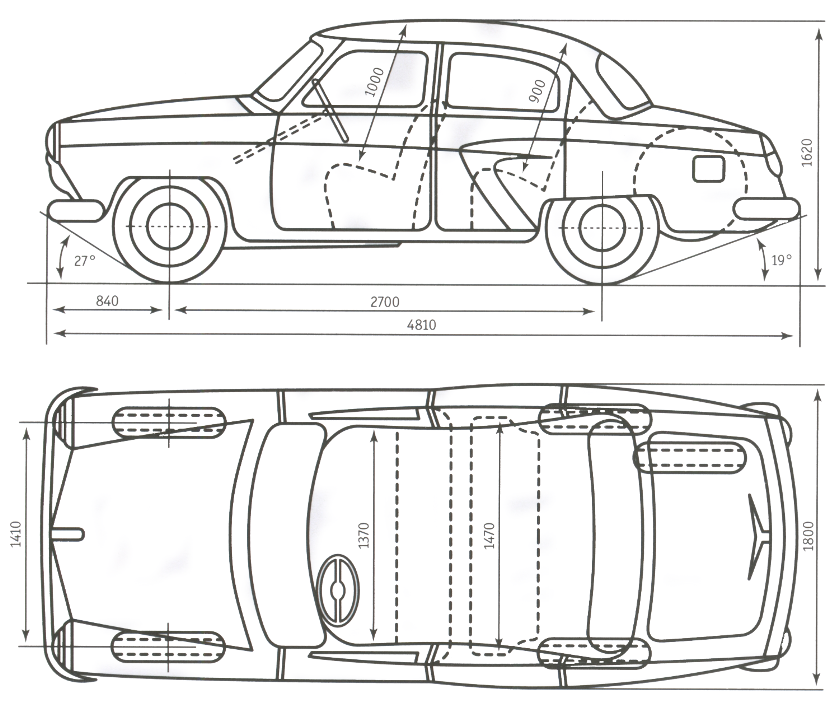
Scheme of the car GAZ-21R "Volga"
| Specifications GAZ-21R "Volga" | Weight, kg | |||
| Number of places | 5 | curb | 1460 | |
| Max speed | 130 km/h | complete, including: | 1885 | |
| Fuel consumption at a speed of 90 km/h | 11.0 - 13.5 l/100 km | to the front axle | 905 | |
| Acceleration to 100 km/h | 32 s | on the rear axle | 980 | |
| electrical equipment | 12V | |||
| Accumulator battery | 6STE-54EM | Lowest ground clearance | 190 mm | |
| Generator | G-12B | |||
| Relay-regulator | RR-24 | Smallest turning radius along the track of the front outer wheel |
6.3 m | |
| Starter | ST-20B | |||
| Distributor breaker | R-23B | |||
| Spark plug | A14U (M16U) | |||
| Tire size | 6,70 - 15 | |||
- Front suspension: independent, spring, double wishbone, hydraulic shock absorbers, telescopic
- Rear suspension: dependent, on longitudinal semi-elliptical springs, hydraulic shock absorbers, telescopic
- Steering gear: globoidal worm with double roller
- Brakes: workers - front and rear drum, hydraulic drive
parking - shoe, on cardan shaft, mechanical drive - Clutch: single disc dry with hydraulic drive
- Transmission: mechanical three-speed with synchronizers in second and third gears
- Gear ratios: I - 3.115; II - 1.772; III - 1.00; reverse - 3,738. Main gear - 4.55
- Carburetor: K-124
- Max Power: 75 HP at 4000 rpm
- Max Torque: 17 kgf.m at 2200 rpm
